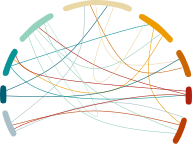
| Retrocopy Name | ATP5MC2P3 |
|
| Species | Homo sapiens | |
| Coordinates (hg38) | chr2:197263056-197263679 UCSC | |
| Coordinates (T2T) | chr2:197746788-197747412 UCSC | |
| Coordinates (hg19) | chr2:198127780-198128403 UCSC | |
| Strand | + | |
| Parental Sequence | NM_005176.7 | |
| Parental seq. overlap | 557 bp | |
| Parental seq. overlap (%) | 87.6% | |
| Genomic Region |
Intragenic (ANKRD44) |
|
| Retrocopy Summary | ATP5MC2P3, located on chr2:197263056-197263679, is a retrocopy of the parental gene ATP5MC2. Retrocopies of protein-coding genes, also known as processed pseudogenes, are intriguing genomic elements with implications in genome evolution and diseases. While some retrocopies are non-functional, there are examples of retrocopies (retrogenes) acquiring regulatory roles or exhibiting neofunctionalization unrelated to their parental genes. |
| Gene Name | ATP5MC2 |
| Full Name | ATP synthase membrane subunit c locus 2 |
| Also known as | ATP5A|ATP5G2 |
| Coordinate | chr12:53665166-53677546 |
| Strand | - |
| Gene summary | This gene encodes a subunit of mitochondrial ATP synthase. Mitochondrial ATP synthase catalyzes ATP synthesis, utilizing an electrochemical gradient of protons across the inner membrane during oxidative phosphorylation. ATP synthase is composed of two linked multi-subunit complexes: the soluble catalytic core, F1, and the membrane-spanning component, Fo, comprising the proton channel. The catalytic portion of mitochondrial ATP synthase consists of 5 different subunits (alpha, beta, gamma, delta, and epsilon) assembled with a stoichiometry of 3 alpha, 3 beta, and single representatives of the gamma, delta, and epsilon subunits. The proton channel likely has nine subunits (a, b, c, d, e, f, g, F6 and 8). There are three separate genes which encode subunit c of the proton channel and they specify precursors with different import sequences but identical mature proteins. The protein encoded by this gene is one of three precursors of subunit c. This gene has multiple pseudogenes. [provided by RefSeq, Jan 2018] |
| Species | Scientific Name | Retrocopy | |
 |
Chimpanzee | Pan troglodytes | ATP5MC2P2 |
 |
Bonobo | Pan paniscus | ATP5MC2P2 |
 |
Gorilla | Gorilla gorilla | ATP5MC2P2 |
 |
Orangutan | Pongo abelii | ATP5MC2P2 |
 |
Gibbon | Nomascus leucogenys | ATP5MC2P4 |
 |
Green monkey | Chlorocebus sabaeus | ATP5G2P1 |
 |
Crab-eating macaque | Macaca fascicularis | ATP5G2P4 |
 |
Rhesus | Macaca mulatta | ATP5MC2P4 |
 |
Baboon | Papio anubis | ATP5MC2P5 |
 |
Golden snub-nosed monkey | Rhinopithecus roxellana | ATP5MC2P5 |
 |
Marmoset | Callithrix jacchus | ATP5MC2P4 |
 |
Mouse lemur | Microcebus murinus | Without Homology |
 |
Mouse | Mus musculus | Without Homology |
 |
Rat | Rattus norvegicus | Without Homology |
 |
Chinese hamster | Cricetulus griseus | Without Homology |
 |
Rabbit | Oryctolagus cuniculus | Without Homology |
 |
Pig | Sus scrofa | Without Homology |
 |
Cow | Bos taurus | Without Homology |
 |
Sheep | Ovis aries | Without Homology |
 |
Dolphin | Tursiops truncatus | Without Homology |
 |
Horse | Equus caballus | Without Homology |
 |
Dog | Canis familiaris | Without Homology |
 |
Panda | Ailuropoda melanoleuca | Without Homology |
 |
Cat | Felis catus | Without Homology |
 |
Pale spear-nosed bat | Phyllostomus discolor | Without Homology |
 |
Velvety free-tailed bat | Molossus molossus | Without Homology |
 |
Greater mouse-eared bat | Myotis myotis | Without Homology |
 |
Kuhl's pipistrelle | Pipistrellus kuhlii | Without Homology |
 |
Greater horseshoe bat | Rhinolophus ferrumequinum | Without Homology |
 |
Egyptian rousette | Rousettus aegyptiacus | Without Homology |
 |
Sloth | Choloepus didactylus | Without Homology |
 |
Tasmanian Devil | Sarcophilus harrisii | Without Homology |
 |
Opossum | Monodelphis domestica | Without Homology |
 |
Platypus | Ornithorhynchus anatinus | Without Homology |
 |
Chicken | Gallus gallus | Without Homology |
 |
Turkey | Meleagris gallopavo | Without Homology |
 |
Zebra Finch | Taeniopygia guttata | Without Homology |
 |
Budgerigar | Melopsittacus undulatus | Without Homology |
 |
Painted Turtle | Chrysemys picta | Without Homology |
 |
Lizard | Anolis Carolinensis | Without Homology |
 |
Frog | Xenopus tropicalis | Without Homology |
 |
Zebrafish | Danio rerio | Without Homology |
 |
Drosophila | Drosophila melanogaster | Without Homology |
| >ATP5MC2P3 |
| GTGTCTTCCCTGCACTGGGCCCAGCTCTCCTGCCACAGCCCCTCACCCCCTGAAAATGTACACCTGCTCCAAGTTCGTCTCCACTCCCTCCTTGGTCAAGAGCGCCTCACAGCTGCTAAGCCATCTGCTACCTGCAGTGGTGCTGAAATGACCAGAGACACTGACAGGTGAGAACCTCAGCAGCTTGGTAGTCTCACGTCCCCTTACCTCACTTGTCCCTGGCCGCAGCTTGGAAAGCAGCGCCATTTCAAGGGACATCGACACAACAGCCAAGTTCATTGGGGCTGGGGCGCCACAGTTGGGGTGGCGGGCTCTGGGGCTGGGATTGCGACTGTGTTTGGGAGCCTCATCATTGATTATGCCAGGAACCCTTCTCTGAAACAACAGCTCTTCTCCTACACCATTCTAGGCTTTACCCTCTAGGAAACCATGGGGCTCTTTTGCCTGATGGTGGCCTTTCTCATCCTCTTCCCCATGTGAAGCAGCTGTCTCCACCTCCCATATTTCTTTCTCCCATGTCTTGTCAGCCCTGTATGTTTCTTTTCCTGCACCTCCCCAGATGGCCTGGGGAACATGGTTGGCTCAGGGTTTGATAGAGGAAAGACAAATACTGTATTAATAAGA |
| >NM_005176.7 |
| CCCCTCTCTGTCTTCTCTGCAGTGGGAGCAGCTCTCCTGCCACAGCTCCTCACCCCCTGAAAATGTTCGCCTGCTCCAAGTTTGTCTCCACTCCCTCCTTGGTCAAGAGCACCTCACAGCTGCTGAGCCGTCCGCTATCTGCAGTGGTGCTGAAACGACCGGAGATACTGACAGATGAGAGCCTCAGCAGCTTGGCAGTCTCATGTCCCCTTACCTCACTTGTCTCTAGCCGCAGCTTCCAAACCAGCGCCATTTCAAGGGACATCGACACAGCAGCCAAGTTCATtggagctggggctgccacagttggggtggctggttctggggctgggattggaactgtgtttgggAGCCTCATCATTGGTTATGCCAGGAACCCTTCTCTGAAGCAACAGCTCTTCTCCTACGCCATTCTGGGCTTTGCCCTCTCGGAGGCCATGGGGCTCTTTTGTCTGATGGTAGCCTTTCTCATCCTCTTTGCCATGTGAAGGAGCCGTCTCCACCTCCCATAGTTCTCCCGCGTCTGGTTGGCCCCGTGTGTTCCTTTTCCTATACCTCCCCAGGCAGCCTGGGGAACGTGGTTGGCTCAGGGTTTGACAGAGAAAAGACAAATAAATACTGTATTAATAAGA |
| PMID - Link | Title |
|---|